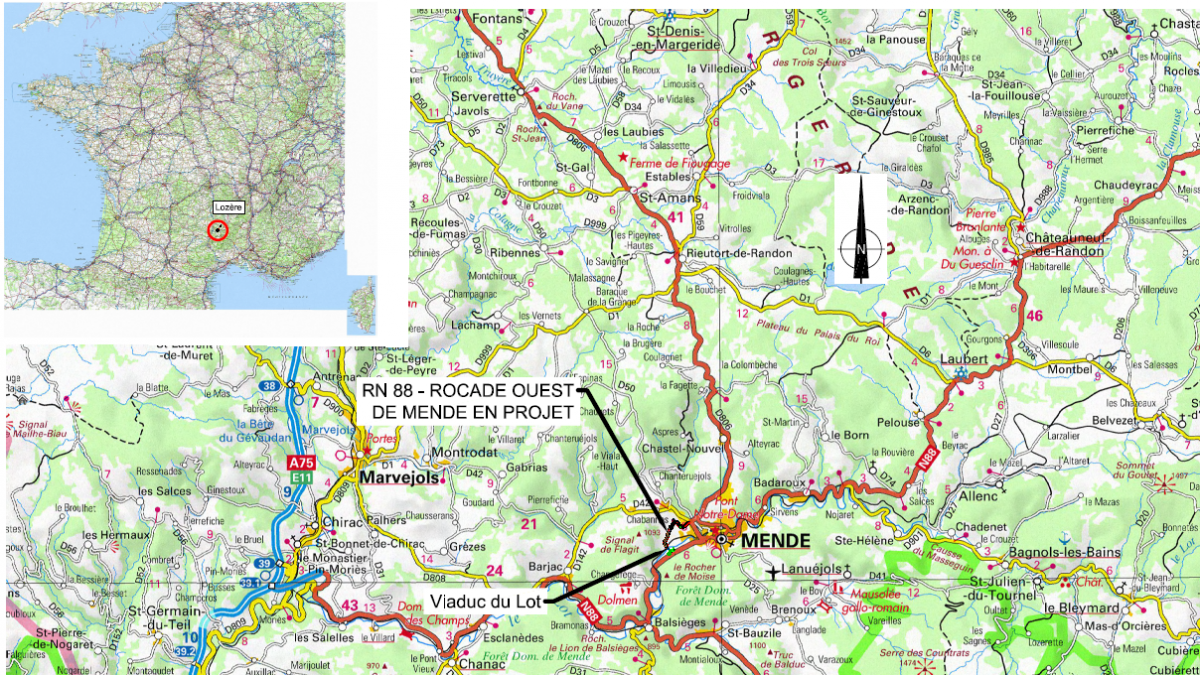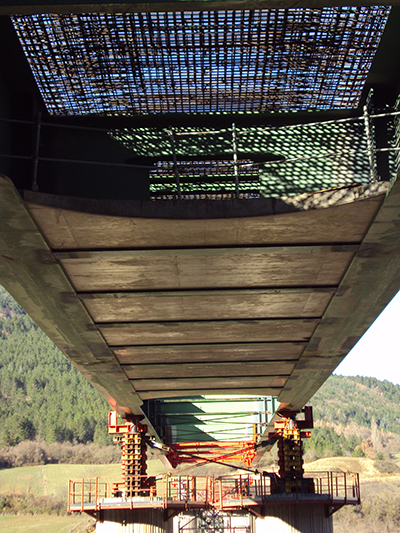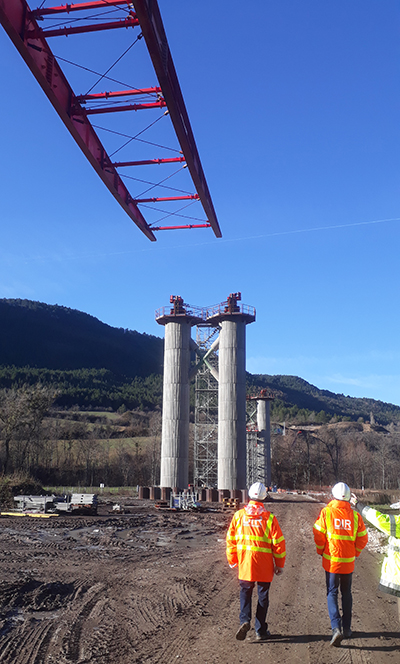
This structure, which will cross the Lot valley and enable users to bypass the centre of Mende is under construction and will be commissioned at the end of 2020.
The composite technique is an innovation that meets the needs for safety and durability of engineering structures

Recent disasters that have occurred on bridges in France and elsewhere remind us of the risks inherent to structures that are being placed under increasing pressure. Road traffic volumes are increasing year after year and climatic factors (temperature, wind, rain) can accelerate the ageing of materials.
Managers of these structures are under an obligation to monitor and maintain the assets that are their responsibility in order to guarantee user safety. When new structures are designed, these issues of future maintenance, durability and safety must be taken into account.
It is to this end that Cerema is making use of its expertise to develop and assess innovative techniques for design of engineering structures.
The solution proposed for construction of the viaduct over the Lot valley near Mende in order to bypass the town centre will increase the robustness of the structure without increasing its cost.
Project context: Mende bypass
As part of the planning for the RN88 road linking Toulouse to Lyon via the A75 motorway, DREAL Occitanie is building a bypass around the Mende conurbation called “Rocade Ouest de Mende”.

To build this bypass it is necessary to cross the Lot valley over a distance of more than 300 m. DREAL Occitanie, the contracting authority for the operation, assigned Cerema the task of designing a viaduct that would cross this valley.
In April 2016, Cerema submitted its project to the contracting authority and the Mende municipal road engineering department (SIR), the project manager. The project consists of an innovative viaduct comprising a Composite deck, the first time this has been proposed in France for a road bridge.
The innovative solution presented by Cerema
To fulfil the requirement, Cerema has designed a composite viaduct comprising five spans of 53 m, 3 × 75 m and 45 m for piers with a maximum height of 22.5 m. The bridge will therefore be 323 m long. It will cross the Lot river as well as a local railway line.

The bridge bearings have deep foundations thanks to a series of 44 piles. The proposed solution fulfils the different requirements of the operation, starting with:
-
reduced cost;
-
considerable strength obtained thanks to the composite innovation;
-
compliance with site requirements, in particular environmental requirements and the presence of wetlands near the construction site;
-
appropriate management of landslide risks concerning the embankments.
The works began in August 2018 and will terminate at the end of 2020. The GTM/Eiffage Metal consortium was awarded the contract.
The viaduct will be delivered at the end of 2020 and will be commissioned early in 2023, after completion of the bypass works. The cost of the viaduct will total 8.6 million euros for a total cost of the bypass estimated at 25 million euros, co-financed by the State (50 %), the Regional Council (19 %), the Departmental Council (19 %) and the municipality of Mende (12 %) (amounts excluding VAT).
The composite technique: an innovation to deliver durability and safety

“Composite steel-concrete” bridges are among the most advantageous engineering structures from the technical and financial viewpoints, and the technique is one of the most frequently used in newbuild projects for span lengths between 40 and 120 m. These bridges benefit from the complementarity between the steel and concrete materials, and from the speed and ease with which they can be built. The concept consists in connecting a concrete slab to the upper portions of two steel beams.
The advantage of the Composite technique is that it increases the safety of the structure without making it more expensive to build. This concept can be used on “double girder composite” bridges. It confers ductility to zones which normally lack it, in this case the areas of the deck in proximity to the intermediate piers. By also connecting a concrete slab to the lower portion of the two main beams, the deck becomes more resistant to instability, which also increases the overall robustness of the structure.
The cost of the slab is compensated by the reduced quantity of structural steelwork required, and so the cost of the structure is unchanged. For the same cost, a Composite double girder structure provides a greater level of safety than a conventional double girder structure.

Cerema is in charge of this innovation, from the feasibility study to monitoring of the structure

Cerema produced the project design, proposing a composite structure, which had never been used before in France for a road bridge.
To perform this task, Cerema made use of skills from the entire organisation for more than three years, in order to define the methodological references for innovative technical aspects not covered by the usual professional standards. A report describing these methodological developments is currently being prepared for publication.
Cerema is going to continue to participate, by carrying out monitoring of the structure during the first few years of operation.
Accordingly, as soon as is built, Cerema’s teams will equip the structure with instrumentation to measure its deformations and better analyse its real behaviour. This scientific approach will generate feedback and help to enrich professional standards relating to the composite technique.
To design and build a bypass road comprising an engineering structure it is necessary to mobilise skills relating to structures, materials, the geotechnical field, earthworks, hydraulics and instrumentation.
Cerema has brought in all these skills, enabling it directly carry out the design studies and provide assistance to the contracting authority and the project manager in key phases: definition of the contracts for the works, inspection of the performance of these works, and monitoring of this technical innovation.

